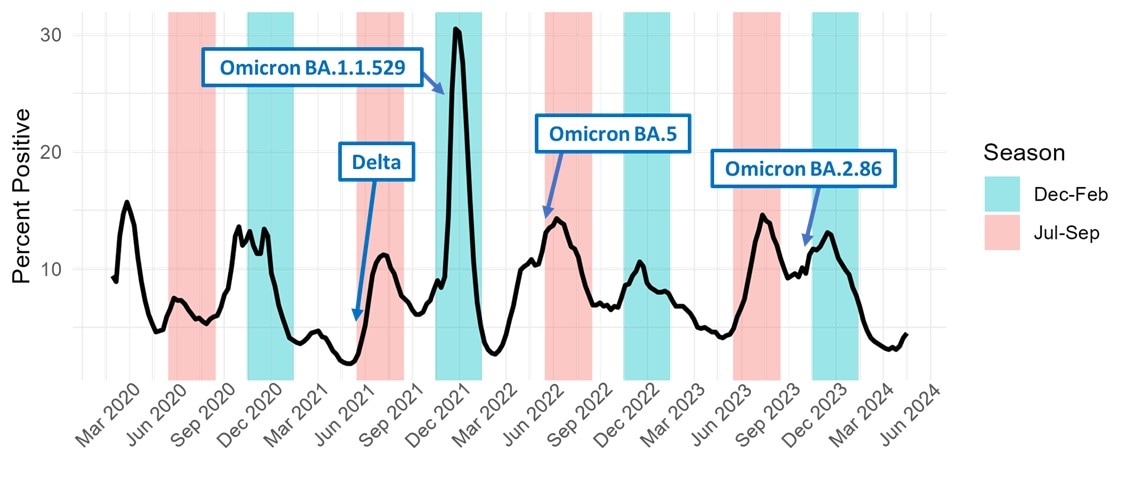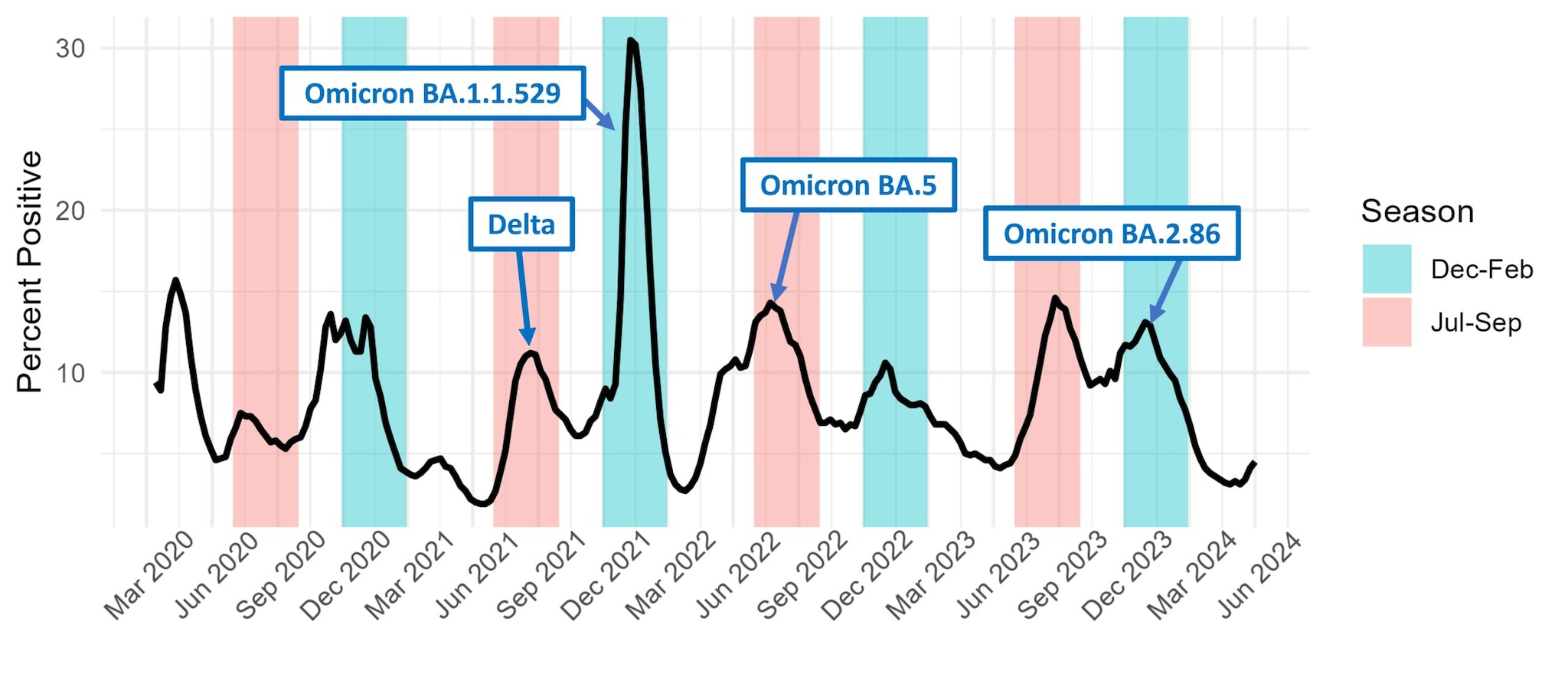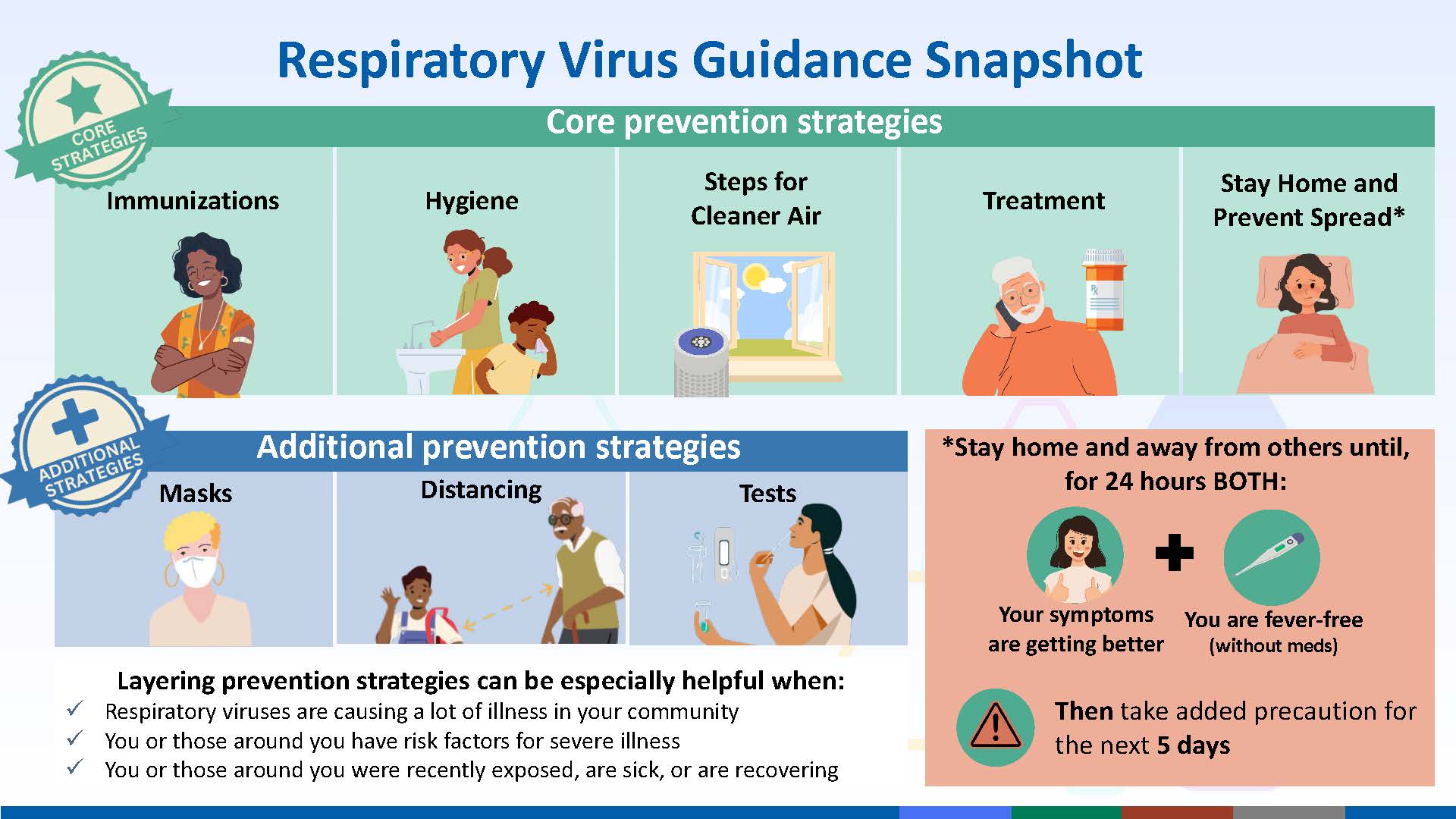At a glance
Many respiratory virus illnesses peak during the winter due to environmental conditions and human behaviors. COVID-19 has peaks in the winter and also at other times of the year, including the summer, driven by new variants and decreasing immunity from previous infections and vaccinations. You can protect yourself from serious illness by staying up to date with vaccinations, getting treated if you have medical conditions that make you more likely to get very sick from COVID-19, and using other strategies outlined in CDC's respiratory virus guidance.

Summary
What CDC knows
In the United States, respiratory virus illnesses typically peak during the fall and winter. These peaks are due to several factors, including human behaviors and environmental conditions that can affect the ability of viruses to survive and spread.
Since the start of the COVID-19 pandemic, infections with SARS-CoV-2, the virus that causes COVID-19, have peaked during the winter and also surged at other times of the year. These periodic surges are due in part to the emergence of new variants and decreasing immunity from previous infections and vaccinations. Because the evolution of new variants remains unpredictable, SARS-CoV-2 is not a typical "winter" respiratory virus.
What CDC is doing
CDC continues to monitor seasonal trends of COVID-19 and the factors driving these trends, including the emergence of new variants, and to collaborate with state and local health departments, commercial laboratories, and global partners. On June 27, the Advisory Committee on Immunization Practices (ACIP), an independent advisory group to CDC, recommended that persons ≥6 months of age receive the 2024–2025 COVID-19 vaccines when they become available this fall.
Why do many respiratory viruses spread more in the winter?
Many respiratory viruses have increased circulation during the winter. Factors that drive these seasonal patterns fall into a few broad categories:
- Environmental conditions: Temperature and humidity can affect the ability of viruses to survive and spread. Dry conditions, which are particularly common in winter, can cause water to evaporate more quickly from respiratory droplets produced by coughing or sneezing, resulting in smaller particles that last longer in the air and travel longer distances. SARS-CoV-2, the virus that causes COVID-19, survives longer in colder temperatures, and increased spread has been associated with lower fall/winter temperatures.
- Immune susceptibility: Dry and cold air interfere with the ability of the body to sweep viruses out of the upper respiratory tract, which is the first line of the immune system's defense. At the population level, protection from prior infection and vaccination wanes over time. This results in more people being susceptible in the winter when respiratory viruses are spreading the most.
- Behavioral patterns: Spending more time indoors with less ventilation during the colder months, as well as holiday gatherings and travel, can increase spread. That's because viruses spread between people more easily indoors than outdoors in part because the concentration of these particles is often higher indoors. Similar conditions can also happen in summer when people spend more time indoors, keep windows closed while using air conditioning, and travel for summer vacations.
COVID-19 seasonality
COVID-19 activity tends to fluctuate with the seasons, meaning it has some seasonal patterns. Data from four years of COVID-19 cases, hospitalizations, and deaths show that COVID-19 has winter peaks (most recently in late December 2023 and early January 2024), but also summer peaks (most recently in July and August of 2023). There is no distinct COVID-19 season like there is for influenza (flu) and respiratory syncytial virus (RSV). While flu and RSV have a generally defined fall/winter seasonality and circulate at low levels in most parts of the United States in the summer, meaningful COVID-19 activity occurs at other times of the year.
Understanding when COVID-19 tends to peak helps to better tailor public health prevention strategies and recommendations, prepare our healthcare system, and allocate resources. That's especially important because the winter peak tends to overlap with those for flu, RSV, and many other viruses. Getting an updated COVID-19 vaccine in the fall can help better protect you through the winter peak. People who might benefit from additional doses of COVID-19 vaccine this summer include those who are:
- 65 years of age and older,
- Moderately or severely immunocompromised or with underlying medical conditions,
- Living in long-term care facilities,
- Of any age and have never received COVID-19 vaccine, and
- Pregnant, especially in late pregnancy.
CDC's Advisory Committee on Immunization Practices (ACIP) met on June 27 and recommended that persons ≥6 months of age receive the 2024–2025 COVID-19 vaccines when they become available this fall. The U.S. Food and Drug Administration recently selected strains for the vaccine based on currently circulating variants.
New variants affect patterns of COVID-19 activity
The emergence of new SARS-CoV-2 variants has been associated with COVID-19 surges, including an increase in the magnitude of winter peaks and additional peaks at other times of the year. Peaks in COVID-19 activity often, but not exclusively, occur in winter (blue bar in chart, below) and in summer (pink bar in chart). New variants, such as Delta and Omicron, contributed to several peaks.
Although the future pace of SARS-CoV-2 evolution is unpredictable, surges outside the winter season will likely continue as long as new variants emerge and immunity from previous infections and vaccinations decreases over time.
CDC continues to track the emergence of new variants through genomic sequencing, in collaboration with state and local health departments, commercial laboratories, and global partners. CDC also continues to monitor trends in COVID-19 to inform vaccine recommendations, and to publish weekly data so that the public can make informed decisions regarding their individual risk throughout the year.
Percentage of positive SARS-CoV-2 tests reported to the National Respiratory and Enteric Virus Surveillance System (NREVSS) -- March 2020 to June 2024

This past winter, COVID-19 peaked in early January, declined rapidly in February and March, and by May 2024 was lower than at any point since March 2020. Over the past few weeks, some surveillance systems have shown small national increases in COVID-19; widespread as well as local surges are possible over the summer months. Although COVID-19 is not the threat it once was, it is still associated with thousands of hospitalizations and hundreds of deaths each week in the United States, and can lead to Long COVID.
Protect yourself and others with practical actions
During the summer and throughout the year, you can use many effective tools to prevent spreading COVID-19 or becoming seriously ill. CDC’s Respiratory Virus Guidance provides recommendations and information that can help people lower their risk from many common respiratory viral illnesses. These actions can help protect yourself and others from health risks caused by these viruses.
COVID-19 is here to stay, but taking simple actions will help protect you and your loved ones from infection and serious illness.

